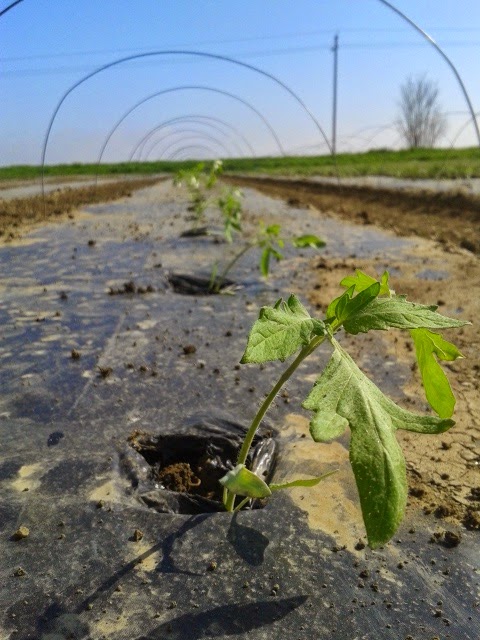It's that time of year again! Strawberries! I blogged last year about how We grow strawberries, which you can read here as well as enjoy an adventurous recipe for strawberry soda, so this year I wanted to talk about how strawberries themselves grow. It's pretty magical that a flower turns into a fat, red, ripe, juice berry. I'll take you down this pictorial journey then share an amazing recipe for strawberry pie!
 |
| The first step a plant takes to creating it's fruit is a flower. These beauties glow a radiant white that contrasts so beautifully against the black plastic and the green leaves. |
 |
| The bees can't resist their radiant beauty. They can be found buzzing away happily in the berry plot all season. Here is one coming in for a landing. |
 |
| Busy bee doing very important pollination work. |
 |
| Once the bee has done her work and the flower is pollinated, the petals dry up and fall off. |
 |
| The flowers center begins to swell and develop seeds. Strawberries are an odd fruit in that their seeds are on the outside. |
 |
| Most plants have berries and flowers at many different stages all at once. It seems like a berry that isn't ripe in the morning, will ripen up by evening, so there is always something to pick! Wednesdays or really early Friday is best. Weekends are usually our busiest, so by Sunday afternoon, there isn't much left. We're open 24 hours, so, if you'd like to U-pick and watch the sunrise- go for it! you'll have the berry patch to yourself! |
 |
| The first berries of the season are always the largest. We grow only Chandler's, a variety developed by UCD for U-pick. They ripen fully red and are tender and juicy. This makes them delectable fresh, but horrible at shipping. They end up mush when in transit...so fresh picked is the only way! I usually don't have to tell people to eat them quick, they're so delicious, they don't last that long! |
 | ||
| I sometimes pick a basket of berries for our farm boxes as a treat. Though, I once did enjoy U-pick, but I-pick as my job is not as fun so I don't let people get used to always having a basket picked by me. It's a lot of work to pick 12 baskets in one day! |
This recipe is so awesome. It makes the best use of seasonal produce: citrus and berries. I do reccomend letting the custard set for the full time.... I didn't and the strawberries made it melt. Not that it wasn't delicious, it was just...melty. Also, do what you want so far as crust. I can't ever make it work so I buy the whole wheat spelt ones from the co-op in the frozen isle. Maybe you're cooler than me and can make it happen- this pie would be amazing with a graham (ooh or chocolate graham) cracker crust. But, do what you can!
Strawberry Lemon Pie
1 pie crust- blind baked
Custard:
1 C sugar
10 TBS butter
4 eggs
1/2 C lemon juice
zest of 2 lemons
Bring out your double boiler. Don't have one? Get a wide, low pot fill half way with water and stack a metal or glass bowl on top (DON'T be lame and use plastic). BAM now you're double boiling! Toss everything in and bring water to boil and cut the heat back to maintain a slight simmer in the water . Whisk the curd gently until it becomes thick and the first bubble forms. Don't let it boil, you'll scramble the egg, and it will be eww. Strain through a fine mesh (like a tea strainer)- or don't, I didn't there are just cooked egg bits that will set. Place in a new bowl, cover with a lid or wrap and let set for two hours or make this a day ahead.
When custard is set, spoon it into the cooled blind baked pie shell and smooth out with a spatula.
Slice up a whole boat load of berries and stack them on top of the custard. If you want to be fancy, melt some chocolate and pour over, maybe dust with cocoa powder or powdered sugar...just go for it! I personally heated up some strawberry cardamom jam I made last year and poured it on top. You could even go with some whipped cream?!
Let me know how it turns out!








